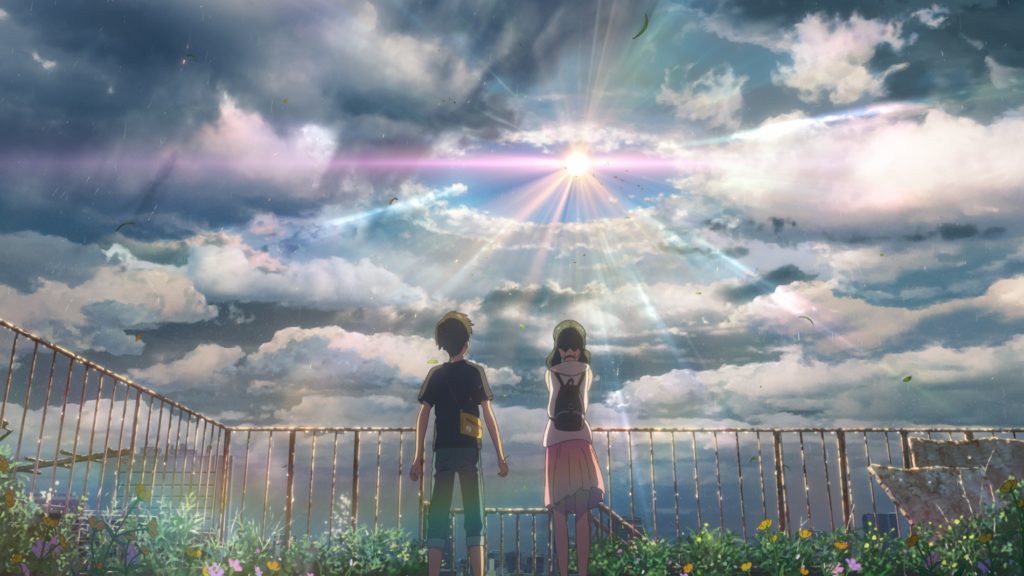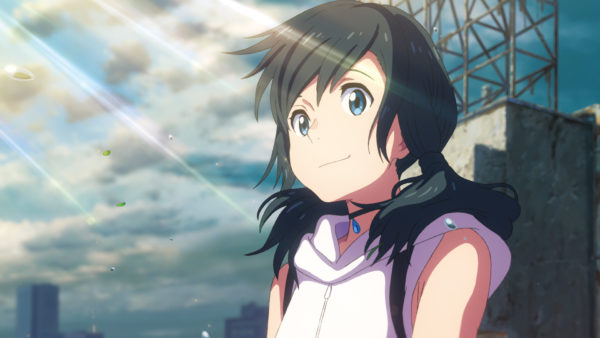Makoto Shinkai has been making animated features since 2004, but his career skyrocketed to new heights with his 2016 release, Your Name. That gorgeously rendered tale of a teenage boy and girl who inexplicably keep switching bodies was a worldwide smash, earning a global total of $357.9 million.
Shinkai’s latest, equally fantastical and equally beautiful new film, Weathering with You, is also an international hit, having earned $175 million outside the United States by the end of November. Japan’s submission for the renamed Oscar category Best International Film (a rare honor for an animated feature), the movie opens in the U.S. on January 17 via GKids.
Weathering with You takes place in a Tokyo of the not-too-distant future, in which climate change has brought unending rain—that is, except for the brief periods when a magical young girl named Hina is able to coax out the sun. Hina strikes up a friendship with Hodaka, a teenage runaway who finds a job as a writer for an occult magazine. Together they start a business temporarily clearing up the weather for people’s special occasions. But Hina’s use of her otherworldly powers comes with a price.

The film is remarkable for its copiously detailed depictions of modern-day Tokyo, often seen in fleeting shots that make you wish you could pause the frame. Shinkai credits his “many wonderful background artists” for the dazzling settings. But, “as with all animation, it all starts with storyboarding, and all the storyboarding I do myself—the angles and all the shots” (1,706 shots in total, he says).
Shinkai admits that the movie’s scenes of constant rain were “a lot of work. When it rains in anime, there’s just so much information, not just visually, but also in the sounds, too. And because the ground gets wet, there’s going to be reflections of people, so you have to draw twice as much. Even on the windows, there’s a lot of water dropping, and you have to draw all of that. It’s just more work. But then I feel like because it was a lot of work, it’s more satisfying to the audience—the audience knows how much work must have gone into it. It’s really satisfying to them, and the more work we put in, the more they appreciate it.”
Weathering with You is clearly inspired by the dire crisis the world faces. “I do have this bitter feeling as an adult,” Shinkai says. “When we were kids, we were told that climate change is happening, and it’s going to get worse unless we do something. It was such a global issue, but then nothing happened. Some countries just opted out of the policies [of change], and now we’re being affected. We can visibly see what climate change has done to our world, and now we’re going to give this world to our children, to the next generation. It’s become a crazy world that we’re [passing down]. It’s not a problem that we can fix in a few years—it’s probably gonna get worse. As adults, we have to think of solutions and we have to worry. But to the children, this crazy, crazy world is normal, because that’s what they were born with. As much as adults need to worry about climate change, I also want kids to be able to enjoy the world that they were given. I want them to laugh, I want them to play. And I think these kinds of feelings are reflected in Hodaka and Hina as the main characters.”
Hina is referred to in the film as a “sunshine girl,” a concept with cultural connotations unfamiliar to Westerners. “Actually in Japan, ‘sunshine girl’ or ‘rainy girl’ or ‘rainy boy’ or ‘sunshine boy’ is actually fairly common, very similar to how Japanese people would say, oh, what’s your blood type? Each blood type has a different personality,” Shinkai explains. “Of course, we know that these are made up. It’s not like all Cancers are a certain way, all blood types are a certain way. We don’t really believe in it, but we just have a feeling like, oh yeah, every time I go outside or every time I have a sports day, it seems to rain. It’s really just a thought that we have. But in Japan we do have a lot of these good-luck-charm-type things, little talismans. When we pass by a torii [shrine] gate, we just naturally put our hands together—we just grew up like that.”
Asked about the inspirations for his two main characters, Shinkai says, “The boy ran away from his island to come to Tokyo. I personally didn’t run away from home, but I always admired Tokyo. After I graduated from high school, I went to Tokyo and studied. So I feel like that guy has some parts of me inside of him. Hina is completely far away from me. She’s very anime-ish and basically like a shrine maiden with these special powers. A typical character from a story is how I first [conceived] her, but once the actor Nana Mori came in and recorded Hina’s voice, I felt like her personality was built.”
For Shinkai, the vocal performances are a welcome unknown as a film takes shape. “In my animation films, everything is hand-drawn. The animators and I control every aspect of the film except for the music and the voices—those are unpredictable. Those are the only things that come from outside of the production teams. When people have a dialogue, we don’t understand each other 100 percent completely. I might say something, and you won’t fully comprehend what I’m saying, or you might take it a different way. So we’re bringing in strangers to this film who might not 100 percent understand it. But that voice brings a different aspect to the film and makes it better. That’s what I look for in a voice.”
Shinkai is part of an esteemed Japanese animation tradition, and a key influence is the internationally revered master Hayao Miyazaki. “I used to sketch and copy Miyazaki’s Nausicaä of the Valley of the Wind when I was in sixth grade,” Shinkai recalls. “And Miyazaki’s Castle in the Sky when I was around 13. I first started doing animation as moving pictures in high school. I had an 8-bit computer and it was only a few cuts, something simple like a door opening or a wheel turning, and then I put the sound in.”
Another role model is Christopher Nolan. “The Dark Knight was very shocking when it first came out, and the use of sound was very different. I’ve watched that and Interstellar many, many times. And I’m in awe each time I watch a Pixar or Disney movie, because they always have something new to bring to the table. I feel bad that we’re put in the same animated feature category. This summer in Japan, for the young people it was, what do we watch—Toy Story 4 or Weathering with You? To be put in the same option is an honor, and I’m proud of what we did. Actually, the same number of people went to watch Weathering with You as Toy Story 4.”
Shinkai uses a surprising term when asked how the huge success of Your Name changed his life. “In one word, it got stuffy. I feel like I’m always being watched. There was an article in a newspaper written about me—not about my work, but about who I’m dating, gossip, like your tabloids. I was really surprised that I was a target of gossip. But then I also realized, oh, I guess that’s how much animation is now getting known in Japan. But it’s still stuffy and exhausting … but I enjoy it, too.”
Despite the meticulous detail he puts into every frame of his films, Shinkai isn’t upset when people watch them on their small screens. “Actually, watching on any device makes me happy—I also watch other people’s movies on my mobile devices. Think about how we used to listen to music when we were younger, on a radio with no surround sound. Favorite songs are favorite songs—we still remember them. … Just like with music on the radio, what you like, you like. Even if they watch on a small device and they don’t see all of the little details, they will get the core of the movie. People who don’t like my movie, even if they watch it in a theater they might not like it anyway.”
Still, Shinkai does appreciate the singularity of the theatrical experience. “Watching [a film] in a theater is something special, because in Japan you have to buy the tickets ahead of time. You usually have to get in a car or on a train to get to the theater. You’re not technically restricted, but you are sitting in the theater for two hours. And so it is a special experience that they put their time and money into. If you want audiences to communicate with the film, the theater is the best place to do it. So I do want the power to make movies that people want to come watch in the theater.”
Thanks to Satsuki Yamashita for her skillful translation during this interview.



Share this post